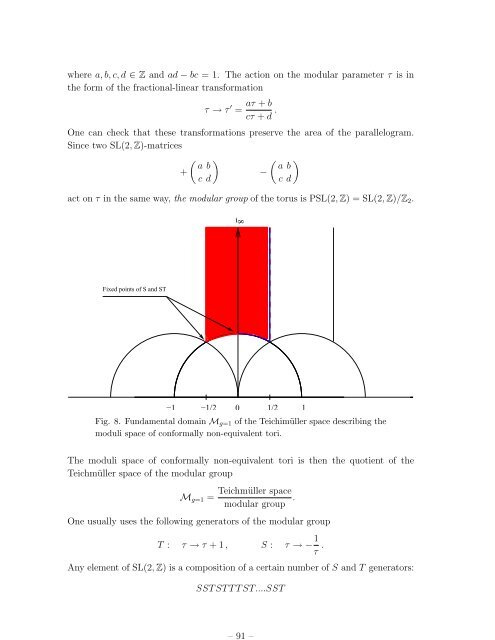Lectures on String Theory
Lectures on String Theory
Lectures on String Theory
Create successful ePaper yourself
Turn your PDF publications into a flip-book with our unique Google optimized e-Paper software.
– 91 –<br />
where a, b, c, d ∈ Z and ad − bc = 1. The acti<strong>on</strong> <strong>on</strong> the modular parameter τ is in<br />
the form of the fracti<strong>on</strong>al-linear transformati<strong>on</strong><br />
τ → τ ′ = aτ + b<br />
cτ + d .<br />
One can check that these transformati<strong>on</strong>s preserve the area of the parallelogram.<br />
Since two SL(2, Z)-matrices<br />
( )<br />
( )<br />
a b<br />
a b<br />
+<br />
−<br />
c d<br />
c d<br />
act <strong>on</strong> τ in the same way, the modular group of the torus is PSL(2, Z) = SL(2, Z)/Z 2 .<br />
i<br />
8<br />
¥¡¥¡¥<br />
¤¡¤¡¤¡¤¡¤¡¤¡¤¡¤<br />
£¡£¡£¡£¡£¡£¡£¡£<br />
£¡£¡£¡£¡£¡£¡£¡£<br />
£¡£¡£¡£¡£¡£¡£¡£<br />
¤¡¤¡¤¡¤¡¤¡¤¡¤¡¤<br />
¤¡¤¡¤¡¤¡¤¡¤¡¤¡¤<br />
¤¡¤¡¤¡¤¡¤¡¤¡¤¡¤<br />
£¡£¡£¡£¡£¡£¡£¡£<br />
¤¡¤¡¤¡¤¡¤¡¤¡¤¡¤<br />
£¡£¡£¡£¡£¡£¡£¡£<br />
¤¡¤¡¤¡¤¡¤¡¤¡¤¡¤<br />
£¡£¡£¡£¡£¡£¡£¡£<br />
¤¡¤¡¤¡¤¡¤¡¤¡¤¡¤<br />
£¡£¡£¡£¡£¡£¡£¡£<br />
¤¡¤¡¤¡¤¡¤¡¤¡¤¡¤<br />
£¡£¡£¡£¡£¡£¡£¡£<br />
¤¡¤¡¤¡¤¡¤¡¤¡¤¡¤<br />
£¡£¡£¡£¡£¡£¡£¡£<br />
¤¡¤¡¤¡¤¡¤¡¤¡¤¡¤<br />
£¡£¡£¡£¡£¡£¡£¡£<br />
¤¡¤¡¤¡¤¡¤¡¤¡¤¡¤<br />
£¡£¡£¡£¡£¡£¡£¡£<br />
¤¡¤¡¤¡¤¡¤¡¤¡¤¡¤<br />
£¡£¡£¡£¡£¡£¡£¡£<br />
¤¡¤¡¤¡¤¡¤¡¤¡¤¡¤<br />
£¡£¡£¡£¡£¡£¡£¡£<br />
¤¡¤¡¤¡¤¡¤¡¤¡¤¡¤<br />
£¡£¡£¡£¡£¡£¡£¡£<br />
¤¡¤¡¤¡¤¡¤¡¤¡¤¡¤<br />
£¡£¡£¡£¡£¡£¡£¡£<br />
¤¡¤¡¤¡¤¡¤¡¤¡¤¡¤<br />
£¡£¡£¡£¡£¡£¡£¡£<br />
¤¡¤¡¤¡¤¡¤¡¤¡¤¡¤<br />
£¡£¡£¡£¡£¡£¡£¡£<br />
Fixed points of S and ST<br />
¤¡¤¡¤¡¤¡¤¡¤¡¤¡¤<br />
£¡£¡£¡£¡£¡£¡£¡£<br />
£¡£¡£¡£¡£¡£¡£¡£<br />
£¡£¡£¡£¡£¡£¡£¡£<br />
£¡£¡£¡£¡£¡£¡£¡£<br />
£¡£¡£¡£¡£¡£¡£¡£<br />
£¡£¡£¡£¡£¡£¡£¡£<br />
¤¡¤¡¤¡¤¡¤¡¤¡¤¡¤<br />
¤¡¤¡¤¡¤¡¤¡¤¡¤¡¤<br />
¤¡¤¡¤¡¤¡¤¡¤¡¤¡¤<br />
¤¡¤¡¤¡¤¡¤¡¤¡¤¡¤<br />
¤¡¤¡¤¡¤¡¤¡¤¡¤¡¤<br />
¤¡¤¡¤¡¤¡¤¡¤¡¤¡¤<br />
£¡£¡£¡£¡£¡£¡£¡£<br />
¦¡¦¡¦ ¥¡¥¡¥<br />
¦¡¦¡¦ ¥¡¥¡¥<br />
¨¡¨<br />
¤¡¤¡¤¡¤¡¤¡¤¡¤¡¤ §¡§<br />
£¡£¡£¡£¡£¡£¡£¡£<br />
¡¡¡¡¡¡<br />
¢¡¢¡¢¡¢¡¢¡¢¡¢¡¢<br />
¦¡¦¡¦ §¡§ ¨¡¨<br />
−1 −1/2 0 1/2 1<br />
Fig. 8. Fundamental domain M g=1 of the Teichimüller space describing the<br />
moduli space of c<strong>on</strong>formally n<strong>on</strong>-equivalent tori.<br />
The moduli space of c<strong>on</strong>formally n<strong>on</strong>-equivalent tori is then the quotient of the<br />
Teichmüller space of the modular group<br />
M g=1 =<br />
Teichmüller space<br />
modular group .<br />
One usually uses the following generators of the modular group<br />
T : τ → τ + 1 , S : τ → − 1 τ .<br />
Any element of SL(2, Z) is a compositi<strong>on</strong> of a certain number of S and T generators:<br />
SST ST T T ST....SST

















